|
Family Tree Magazine
|
May 2009
 |
Website tour

Mike Ratcliff takes you on a tour of this invaluable website, to show you just which records are available, and how its search facilities will help you to find your ancestors. |
 |
| You can find the entry for a street address without having to know who lives there |
As with many websites of this kind, www.thegenealogist.co.uk offers core sources essential to every family historian. Key records include the censuses for England and Wales (1841-1901) and the civil registration indexes of births, marriages and deaths (BMD) 1837-2005.
What's particularly different about TheGenealogist.co.uk (TG) is the range of powerful tools available for locating your ancestors. Once you have logged in from the home page, you will find the four kinds of search facilities at the top of the 'Research View'.
Note that the addition of original images of the 1881 Census is nearly complete; the 1881 Census is the last to be added in the light of the longstanding and widespread availability of free transcripts elsewhere. As we shall see TG also has other databases, some of which are unique. |
Accuracy
To enable us to search for ancestors in the censuses online, we rely on the fact that teams of transcribers have painstakingly read, and keyed into a computer, every single one of the millions of entries.
Errors do occur during the process, but TG has an enviable reputation with genealogists for the high quality of its transcriptions.
TG allows you to view an image of the original page so you can confirm the transcribed information before printing or storing it on your computer for future reference. |
|
Full Transcription
Before you can enjoy reading your ancestor's census entry, you have to find it. That can sometimes be easier said than done. If the surname is unusual and your ancestors live in a small town or village, the search can be brief, but a John Smith resident in London can take many hours of your like. The more you know about a person, such as age, occupation, address, where born and so forth, the easier the search should become. However, if each entry is not fully transcribed, the criteria you can use is more limited. On TG much of the data has been transcribed, with a 'field' for each piece of information. There is a button to the right of each entry to correct any errors or report a poor quality image. |
|
Keyword Master Search
Apart from street names , the full census transcription also extemds our search capabilities by including people's occupations. That elusive John Smith may be hard to track down with just his name and age, but enabling us to specify that he is a carpenter is going to shorten the list of possible matches considerably.
The Keyword Master Search is a handy way to dive in with a quick query. It acts rather like an internet search engine, so for example 'john smith carpenter london' plus the selection of a particular census year such as 1901, narrows the search and yields 65 matches. You can also limit the census search to an individual county. The Keyword Master Search also allows you to search for names in the BMD (1984-2005) indexes, parish records, and other data sets. |
|
Family Forename Search
One way to identify a family in the census is by the combination of forenames for the parents and their children and their corresponding birth years. As many families had a large number of children the odds of another family in the same county being an exact match is quite remote, which TG uses to its advantage with its Family Forename Search.
I tried this by entering five common forenames with no dates for a family I knew existed in the 1871 Census, clicked on Search, and within 10 seconds it had found the 323 families in the whole census with that combination of names. When I specified the county to search, it quickly narrowed it down to two families. This is a useful feature that you can further refine by entering a birth year for one or more of the forenames, or by adding the family surnames. |
|
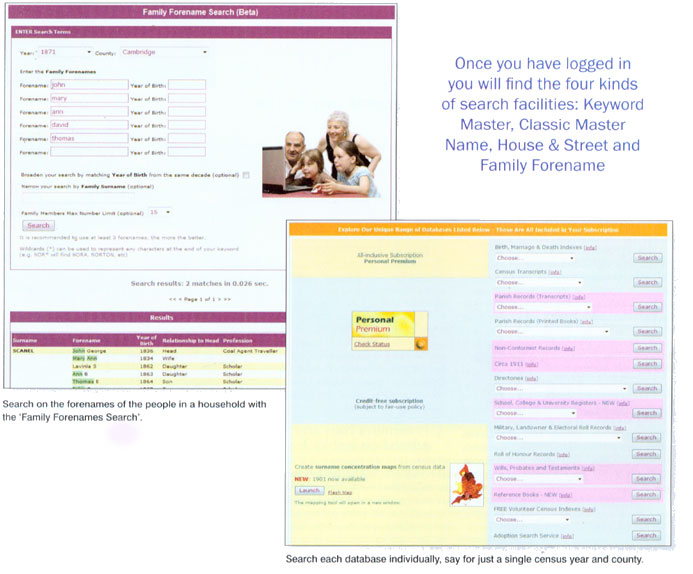
|
Single Database Searches
TG has a large number of databases which can be searched individually; scroll down the Research View to find the list which gives you direct access to these. TG has death records for both world wars and there is an ongoing project to document overseas BMD records for members of the British armed forces. The TG website is also adding transcripts or page images of parish records, marriage registers, Nonconformist records, trade directories, school records, will indexes and other publications for various counties and eras, many of which cover periods before the census and civil registration and some are not available elsewhere.
Each category listed offers a choice of records within that category and then opens a window with the applicable search fields for your chosen document. The census window offers a basic search on name and age, with the option for phonetic variations and nicknames - a rather clever system that identifies variants of forenames, such as Betty, Betsy, Beth and Liz as being Elizabeth. Switch to Advanced Search and you have all these options plus the ability to specify data for all the fields in the census form, including street address and occupation. |
|
Types of Subscription
All hobbies cost money, and researching your family tree is no exception. There are different plans available at TG that attempt to match different user's needs - from the person who is researching a whole tree to the one returning to confirm a few facts. If you don't want any usage limitations, the Personal Premium subscription at £68.95 for a year, or £39.95 for six months, offers you unlimited credit usage.
An alternative is the Personal Plus option, which buys credits that are used each time you view a document. This plan ranges from £14.95 per quarter to £55.95 per year, with unused credits carried over to the following period. For the occasional user who just wants to see a few records the Personal Pay-as-you-go buys a number of credits, from £5.
If you are tempted by the idea of credits, in whichever plan, it's worth checking the credits page on the website as many views cost more than a single credit and may not go as far as you expect. |
|
House and Street Search
One of the advantages of the full transcription on TG is that you can find the entry for a street address without having to know who lives there.
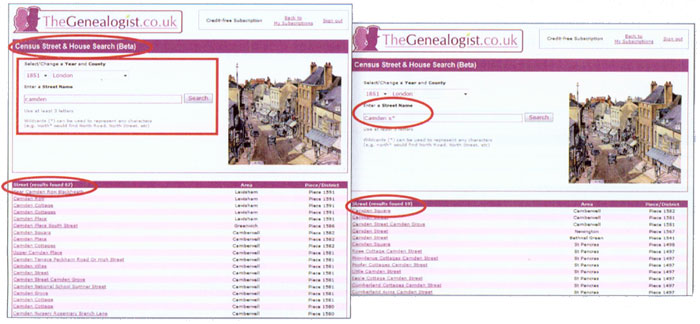
Using House and Street Search, select the year, such as 1851, the county as London and the street name as Camden. It produces a list of 67 addresses containing that word - in this case including house names, dairies and a school.
If you wanted to, say, find Camden Street you could enter the full name, but the census may have recorded that as 'Street', 'St' or 'Str'. Since the search engine accepts the wildcard '*' symbol to represent one or more letters, a search on 'Camden S*' will capture these variations; the result is 19 entries, limited to streets and one 'square'. In large cities, even the same street name may have been used more than once, so the adjacent listing of the area, such as Camberwell or St Pancras, for each one is a welcome feature.
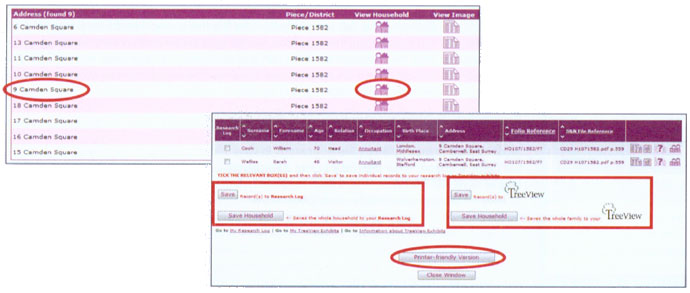
Once you have located the correct street, Camden Square, Camberwell for instance, selecting its name opens a new list of all the addresses it contains.
If you know the house number or name, its 'View Household' button instantly displays the entry for that address to confirm your search (or you can immediately display the original image and download it). If you are not sure of the house number, it's a case of clicking on all the buttons until you find a name you recognise. Selecting the household view for 9 Camden Square shows that the household comprises just William Cook and a visitor, Sarah Walliss, both annuitants.
You can print the household view using the 'Printer-friendly Version' button or, by using the buttons to the right of the entries, you can view and download the original image, add a correction or query an entry. At the bottom of the household view you can also see two other features that TG has to offer, the Research Log and the TreeView.
Research Log and TreeView
You can save each record or each household to a 'Research Log' or to a 'Tree View'. The Research Log enables you to save possible matches for future reference. If any of them turn out to be red herrings, you can delete them or add a note to say why they are not relevant. You can also build your tree on the website using Tree View, which you can access from any computer by logging on to your account. You may also load a GEDCOM file of any existing tree and add on to it as your research progresses. At any time you can download your expanded tree as another GEDCOM back to you computer. Online trees are a great way to share information with other family members, and with TreeView you have the choice to keep your chart private, make it public, or make it available only to invited friends. |
|
Classic Master Name Search
Entering a name in the Classic Master Name Search opens a window showing the number of occurences in each census year and in the indexes of civil registration births and marriages from 1984-2005. In this example, we'll search for Benjamin Garnham.
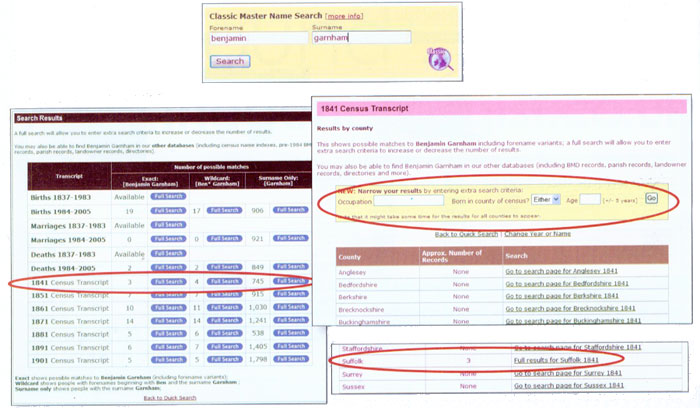
The search results show the number of times the name occurs in the various datasets. For instance, there are just three occurences of the exact name in the 1841 Census, four based on Ben* Garnham and 714 with just the surname Garnham. Selecting the 'full search' button, for the three exact results for Benjamin Garnham in the 1841 Census, brings up a list for each county, showing how many instances of the name occur in each. In this case, all three are in Suffolk. There are new options to narrow the results further by occupation, whether born in county, and by age.
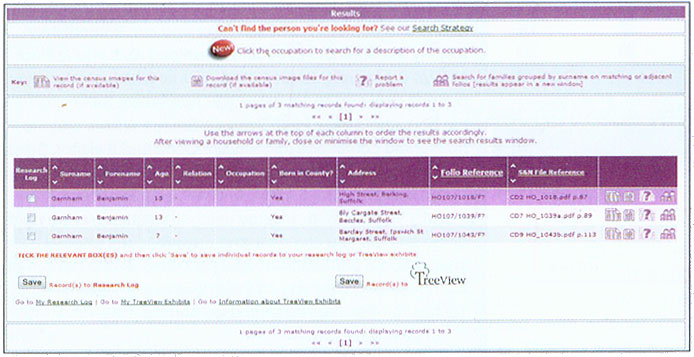
By selecting 'Full results for Suffolk 1841', details of the three individuals are displayed with similar options, as described in the House or Street Search. To view the original image, enter the records into a Research Log or save into TreeView. A new feature allows you to click on an occupation for a description of the occupation.
Classic Master Name Search
The Classic Master Name Search also gives you the option to view images of the pre-1984 BMD indexes, which lists registered names by quarters for the selected years. The first and last names on each alphabetical page have been digitised so the system can point you to the correct page image. If you do not know the exact year and quarter you are searching for, there is no other method but to work through all the relevant pages for every quarter of the likely years. It is useful to check this way is an expected entry does not appear in transcribed indexes, as some entries may be accidently missed out or mistranscribed. Whichever BMD era interests you, TG provides the references needed to order a copy of the original certificate and all the invaluable information it contains. |
|
In conclusion...
Overall this website offers an excellent range of records. In addition, it has held its prices for a number of years while regularly adding data to the website. The fact that the censuses are fully transcribed makes searching comprehensive and very effective, and the Family Forenames Search adds a powerful tool to the family historian's armoury. The Research Log and TreeView features also make this a site well worth your consideration. New data and search options will continue to appear on TG. The range of subscription options tries to meet the needs of every user, and it's worth spending time considering which one is right for you. For all but the occasional user I would recommend the unlimited Personal Premium plan. Go and take a look for yourself, and perhaps take the free trial. |
Review by Mike Ratcliff |
|
 |
 |
|
|